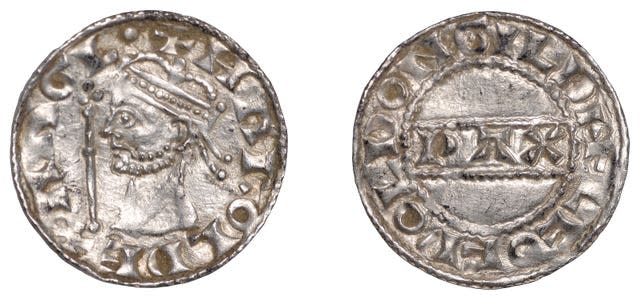Coins found by two metal detectorists sold at auction for more than £325,000
A hoard of 122 Anglo-Saxon pennies that was found by two metal detectorists has sold at auction for £325,560.
It is thought the coins, discovered near Braintree in Essex, were buried in 1066, the year of the battle between English and Norman armies for the throne of England.
An expert said there was a “tantalising possibility” that the reason they were not retrieved at the time was because their owner died in battle.
They sold at Noonans Mayfair in London for a hammer price of £325,560 on Wednesday.
They had been expected to fetch up to £180,000 with the proceeds of the hoard being shared between the two finders and the landowner.
Following the sale, Nigel Mills, Artefact and Coin Expert at Noonans, said: “Wow, this has exceeded all our expectations.

“The atmosphere in the packed saleroom was euphoric with bidders – in person and online – wanting to purchase just one example from this important collection.”
Two metal detectorists discovered the hoard of 144 coins in 2019, and 16 of them were bought by Colchester Museum and Cambridge’s Fitzwilliam Museum after they were processed under the terms of the 1996 Treasure Act.
The coins bought by the museums included two 11th century Byzantine coins.
In late 2023, the remaining coins were disclaimed and returned to the finders.
Noonans Mayfair auctioned off 122 of the coins, with the others kept by the metal detectorists.
It is thought the coins were buried in 1066, within five years of all bar two of the coins being minted.
The highest price of the sale was paid for a very rare single specimen from the Hastings mint which fetched a hammer price of £24,000 – four times its pre-sale high estimate of £5,000-6,000.
It was bought by an online bidder
Noonans Coin specialist Bradley Hopper said: “While the deposition of the Braintree Hoard might not relate directly to the events of 1066, the fact that it was never recovered surely did.
“Twelve shillings was a considerable sum of money, and its retrieval must have been prevented by some great personal misfortune; we cannot say with any certainty whether or not the Braintree hoard’s owner died fighting at Hastings, but it is a tantalising possibility.”
The two detectorists who have been searching together for 20 years had only found copper coins and crotal bells previously on the field, but on this day a signal from the Minelab CTX 3030 revealed at a depth of only four inches a silver penny that was not recognisable.
Half a dozen more turned up in a 30-metre radius and that evening they realised they were rare pennies of Harold II.
Over the next few days around 70 more were found by slow and methodical use of the detectors.
This was repeated in 2020 with another 70 coins uncovered.
The landowners attended the sale and afterwards said: “We are delighted with the results which is a life-changing amount of money for the finders.”


